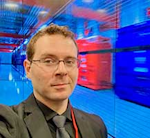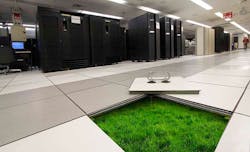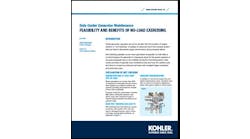In today’s fast-growing data center industry, going green isn’t only good for the environment, it’s also good for business. Over the years. we’ve seen more solutions to help your data center become more efficient and friendlier to our environment. However, some would argue that the race towards greater renewable energy consumption is just now heating up.
Something has been happening with our data centers over the past decade. Renewable energy, which was once seen as an expensive luxury, now provides stable sources of power while still helping keep PUEs (Power Usage Efficiency, a leading efficiency metric) nice and low. In fact, some leading data center providers build an entire business model when it comes to green solutions.
Some even put it in their name, like Green House Data, which has been doing “green” since around 2007. Today, the company is 100 percent wind-powered and super proud of it. With an average Power Usage Effectiveness (PUE) of 1.25 or lower (and 1.14 at its data center in Cheyenne, Wyoming), Green House Data now ranks 25th on the EPA’s list of Top 30 Tech and Telecom. Beyond just wind, they employ free cooling all year-round, work with customized modular data center designs, work very closely with new solutions around density and virtualization, and they carefully monitor power and temperature measurements.
Green House Data provides an example of how you don’t have to be a cloud titan to embrace the core belief that green is simply better. Although, truth be told, it helps to be a cloud titan.
Huge cloud-minded organizations have been stepping up their use of renewable energy for years. Services like iTunes, Siri, Maps and the App Store now get 100 percent of their power from a combination of renewable energy Apple purchases on-site generation capacity at the company’s data centers. Apple says it already achieves 100 percent renewable energy at all of its data centers.
Looking at Green Momentum
Most recently, the data center industry’s adoption of green power has accelerated. In March of this year, Microsoft signed a power purchase agreement (PPA) for 315 MW of solar capacity in Virginia with US renewables company sPower. According to Microsoft, this marks the single largest corporate purchase of solar energy in the US. This type of deal and contract will help Microsoft meet its goal of powering 60 percent of its data centers with clean energy by early 2020.
Microsoft is one of five hyperscale or cloud firms among the top corporate users of renewable energy in the world. The others include Amazon, Apple, Facebook and Google (we’ll talk about them in a minute).
Despite what you might conclude from our current political climate, the volume of coal continues to decline in production, while, renewable energy as a percentage of total US energy generation continues to rise, doubling since 2008.
According to the recent Bloomberg New Energy Finance report, forty-three businesses signed long-term agreements for a record 5.4 gigawatts of clean power including solar and wind worldwide last year. This is up from 4.3 gigawatts from the previous year and, according to Bloomberg, enough to displace 10 coal-fired power plants.
How is the rest of the industry keeping up? And, what are their initiatives to move to a greener data center platform?
Our Data Center World Is Getting Greener
Let’s switch gears and look at the rest of the industry. At the latest AFCOM Data Center World conference, I had the chance to walk the expo hall and talk to a few data center leaders. It became pretty clear that they’re all focusing on creating a greener data center ecosystem. Plus, many of them are actually investing new kinds of solutions when it comes to renewable energy sources.
Findings from the AFCOM State of the Data Center report support these conversations and the direction of the industry in general.
Data center operators’ plans to invest in renewable energy, from the AFCOM State of the Data Center survey. Click image for a larger version. (Graphic: AFCOM)
One in four respondents are currently leveraging renewable energy in their data centers. An additional 27% are planning to do so within the next three years, including 10% who are looking into doing so immediately. What are the most popular renewable energies? According to the report, Solar energy is most popular among respondent companies, followed by hydro and wind.
These are some serious numbers to consider. The fact that so many data center leaders are investing in renewable energy sources indicates that there are some real benefits to both the business and the data center. When it comes to actually realizing the benefits, respondents indicated that investing in renewable energy sources did the following:
- It will help the organization achieve green initiatives
- It will help lower the ROI and/or the TCO of the data center
- Renewable resources help with brand and image for my company/data center
- Renewable resources are a lot more affordable.
What About Your Data Center?
For your own data center architecture, working with renewable energy sources can make a lot of sense. But you need to know if it’s a path you’re ready to take. Working with energy partners can help you understand the cost of purchasing renewable energy sources and how they match up with your current plans.
It’s critical to conduct an ROI analysis and tie in your business to make the final decision. Organizations across the world are going to leverage renewable energy sources as they come down in price and help improve a variety of functions.
Consider the journey that Google took. “A little over a year ago, we announced that we were on track to purchase enough renewable energy to match all the electricity we consumed over the next year,” wrote Michael Terrell, head of Google Energy Policy. “We just completed the accounting for Google’s 2017 energy use and it’s official—we met our goal.”
This means that Google’s total purchase of renewable energy sources actually exceeded the amount of electricity used by their data center operations, globally. According to Google, they’re set to purchase more renewable energy than anyone else in the market. In fact, they have contracts in place to purchase three gigawatts (3GW) of output from renewable energy projects. This makes Google the biggest corporate buyer of renewable energy on the planet.
“We have the ability to shape the market,” said Michael Terrell, head of Google Energy Policy. “If you build it, we will come.”
Looking Ahead
It’s exciting to see our world becoming a greener place. And, it’s amazing to see the data center industry taking charge. Remember, one of the major initiatives we’re seeing today revolves around the distribution of IT and even edge solutions. All of this translates to the further growth in the data center market, where energy and power density will be requirements. As you build out your data center solutions for core or edge architectures, be sure to look at renewable energy sources as real-world options to help both your business and the efficiency of your data center.






